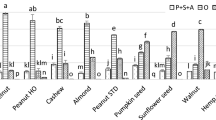Abstract
The fatty acid and triacylglycerol composition of pili nut (Canarium ovatum) oil and fractions were analyzed by gas chromatography and reversed-phase high-performance liquid chromatography, respectively. The oil obtained by solvent extraction was low in polyunsaturated fatty acids and high in saturates. The polyunsaturated fatty acid (18∶2 and 18∶3) contents were less than 11%, whereas palmitic (16∶0) and stearic acid (18∶0) were 33.3 and 10.9%, respectively. The saturated fatty acid level of the low-melting fraction oil was reduced from 44.4 to 35.5% and the total unsaturated fatty acid levels were increased from 55.6 to 65% by fractional crystallization. Triacylglycerol analysis showed that the high-melting fraction (HM) from pili nut oil consisted of POP, POS, and SOS+SSO (P=palmitic acid, O=oleic acid, and S=stearic acid) in the proportion of 48.6, 38.8, and 8.7%, respectively. The physicochemical properties of the HM fraction were studied using differential scanning calorimetry and pulsed nuclear magnetic resonance. The results showed that the melting range and solid fat content of the HM fraction were very similar to those isolated from cocoa butter and olive oil. The content of POP played an important role in determining the melting range of the HM fraction. It is suggested that this HM fraction may have applications as a cocoa butter substitute in confectionery products.
Similar content being viewed by others
References
Neal, M.C., In Gardens of Hawaii, Bernice P. Bishop Museum, Special Pub. Bishop Museum Press, Honolulu 1965.
Coronel, R.E., and J.C. Zuno, Note: The Correlation Between Some Fruit Characters of Pili, Philipp Agric. 63:163–165 (1980).
Coronel, R.E., and J.C. Zuno, Note: Evaluation of Fruit Characters of Some Pili Seeding Trees in Calauan and Los Banos, Laguna, —Ibid. 63:166–173 (1980).
Coronel, R.E., J.C. Zuno, and R.C. Sotto, Promising Fruits of the Philippines, University of Philippines at Los Banos, College of Agriculture, Laguna, 1983, pp. 325–350.
Mohr, V.E., and G. Wichmann, Cultivation of Pili Nut Canarium ovatum and the Composition of Fatty Acids and Triglycerides of the Oil, Fett Wiss. Technol. 89:128–129 (1987).
Sassano, G.J., and B.S.J. Jeffrey, Gas Chromatography of Triacylglycerols in Palm Oil Fractions with Medium-Polarity Wide-Bore Columns, J. Am. Oil Chem. Soc. 70:1111–1114 (1993).
Raclot, T., Selective Mobilization of Fatty Acids from White Fat Cells: Evidence for a Relationship to the Polarity of Triacylglycerols, Biochem. J. 322:483–489 (1997).
Weidermann, L.H., Margarine and Margarine Oil, Formulation and Control, J. Am. Oil Chem. Soc. 55:823–829 (1987).
Official Methods and Recommended Practices of the American Oil Chemists' Society, American Oil Chemists' Society, Champaign, Methods Ce 2-66 (1992), Ce 5b-89 (1995), and Cd 16b-93 (1996).
Author information
Authors and Affiliations
About this article
Cite this article
Kakuda, Y., Jahaniaval, F., Marcone, M.F. et al. Characterization of pili nut (Canarium ovatum) oil: Fatty acid and triacylglycerol composition and physicochemical properties. J Amer Oil Chem Soc 77, 991–997 (2000). https://doi.org/10.1007/s11746-000-0156-8
Received:
Accepted:
Issue Date:
DOI: https://doi.org/10.1007/s11746-000-0156-8




